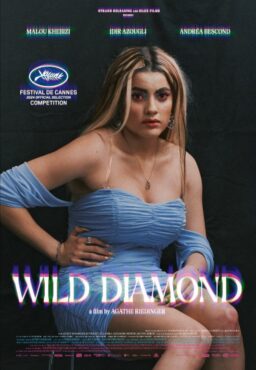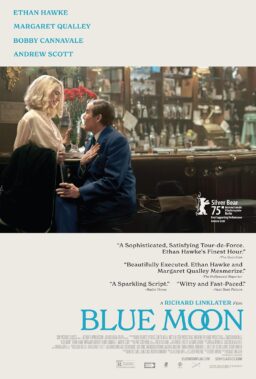A trick of reality television is to have subjects talk in the present tense about past events, narrating though their experiences as if they are actually happening in here and now. If a show is working its spell through the juxtaposition of footage and talking heads, we quickly forget about the fact that the person speaking to us hasn’t left the couch or changed outfits in between recounted scenarios, and that their observations are being made in hindsight. Nicole Nielsen Horanyi’s cleverly constructed Danish mystery, “The Stranger,” winner of the Grand Jury Prize at last year’s DOC NYC festival, builds off this concept in innovative ways, splintering the usual boundaries of documentary and scripted narrative by having the majority of its participants “play themselves.” Leading lady Amanda Kastrup straddles the line between performance and pure confession, as she restages a real-life relationship from 2011 that left a traumatic residue in its wake. Esben Dalgaard Andersen is splendid in the role of her boyfriend, Casper, a genial man of extravagant wealth whose carefree smile harbors a multitude of secrets. As with Kurt Kuenne’s staggering “Dear Zachary: A Letter to a Son About His Father” or Tim Wardle’s recent hit “Three Identical Strangers,” it’s best to go into Horanyi’s picture knowing as little as possible. It’s obvious from the get-go that we’re in store for some sort of twist, and when it arrives, it’s a doozy, yet what impresses even moreso is the overall structure of the piece.
Playing with the form much like Robert Greene (“Bisbee ’17,” “Kate Plays Christine”), Horanyi allows Kastrup—and the viewer—to become intimately involved in a given scene until it is ruptured by a boom mic or a botched take. The director will occasionally interrupt the actors, voicing the audience’s thoughts by questioning Kastrup on why she behaved in the way that she did. Andersen is somehow able to remain wholly in character as Kastrup breaks the fourth wall, articulating her inner thoughts directly into the lens. This approach amounts to much more than performance art, as the story evolves into a microcosm for the degree to which we are all performing for one another online. Social media requires us to place our trust in faces that we may never meet in person, and may conceal the worst of intentions, as the Russian bots did during the 2016 election. We’ve become all too accustomed to reading into images and emojis, projecting our desire for human connection into the cold glow of our screens. Kastrup’s tale is a cautionary one, without question, yet it is not without empathy, inviting us to feel for those lonely souls so desperate to escape their existence that they believe companionship can be won only by living in a lie.

How precisely does one go about following up one of the greatest debut features in cinema history? László Nemes’ “Son of Saul” was unlike any Holocaust picture ever made, containing our perspective within that of the titular character, a Sonderkommando forced to guide fellow prisoners to their doom at Auschwitz. Mátyás Erdély’s visceral cinematography followed closely behind Saul while blurring the surrounding horrors, thereby illustrating the self-imposed tunnel vision that enabled him to preserve his sanity. Having witnessed the carnage in archival footage and various graphic dramatizations, we know fully well what is escaping our gaze, and its abstracted form combined with the grueling sound design caused the atrocities to be branded as vividly as ever in my mind. When I interviewed Nemes prior to the film’s Chicago release, he spoke beautifully about the ways in which our imagination becomes interlinked with the cinematic mirage. “When you’re watching film, it is a hypnotic process—between each still image that is projected, you have darkness,” he told me. “Fifty percent of the experience is darkness, and the way in which the two images become movement is pure magic.” By keeping our focus so transfixed on the face and movement of his lead protagonist, we become that person, in a sense, placing our own thoughts and emotions onto the blankness interspersed between every frame.
Nemes and Erdély are clearly aiming for that same mesmerizing level of immersion with their second feature-length collaboration, “Sunset,” a spiritual prequel to “Son of Saul” set in Budapest circa 1913, teetering on the brink of World War I. Juli Jakab turns in entrancing work as Írisz Leiter, a woman searching to discover the identity of her notorious brother, whose very existence had been kept a secret throughout her life. After her attempt to land a job at her deceased parents’ celebrated hat shop is thwarted, Leiter unearths one level of corruption after another, though the particulars of the plot grow increasingly murky as the story progresses. The period detail is often sumptuous to behold, with Györgyi Szakács’ exquisite costume designs calling to mind Georges Seurat’s A Sunday Afternoon on the Island of La Grande Jatte. So elaborate are the hat designs that when viewed on their own, they resemble alien life forms. Of course, Nemes wants to uncover the primal madness that such societal refinement conceals, yet with a running time clocking in at 142 minutes, the script spends spends far too much time coasting on ominous riddles (“Your brother saw horror in the world—but it came from him!” one character ambiguously declares). László Melis’ score repeatedly echoes the atonal bellowing of Jonny Greenwood’s “There Will Be Blood” opus, as impending violence proves inescapable. When it finally erupts, the bravura choreography captured in long takes is frustratingly obscured, with Erdély making the mistake of recycling the same visual technique that worked far better and had more thematic depth in “Saul.” Not only do the backgrounds rarely come into focus, the story never rises above the level of incoherence.

Ever since the release of Jonah Bekor and Zach Math’s “The Final Member,” a delightful 2012 documentary about teacher-turned-curator Sigurður Hjartarson’s pursuit to complete his collection of phalluses (one for every mammal on earth), the specimens’ permanent home at the Icelandic Phallological Museum has become one of the unmissable tourist destinations in Reykjavík. Located just blocks away from the festival’s central hub, the museum contains no less than 280 penises from 93 species of animals, not to mention silver casts of the Icelandic National Handball Team’s members (pictured above) after earning their country its second Olympic silver medal in 2008. Though the exhibit does’t take long to walk through, the audio tour alone is worth the price of admission, featuring dryly hilarious narration from Hjartarson, who delivers bizarre data—such as the number of sperm gallons a blue whale ejaculates—in the tone of Werner Herzog. One seemingly empty bell jar allegedly contains a penis from the species of “huldufólk” (elves) prominent in Icelandic folklore, which Hjartarson insists will be visible only to “the most astute.” The sole human penis on display, rendered nearly unrecognizable, was donated by 95-year-old Pall Arason, an Icelandic man who claimed to have bedded over 300 women. Hjartarson begins the audio track by admitting that he began the museum after his wife refused to let him keep his exceedingly odd collection at their home.
Needless to say, I was laughing quite a bit throughout the tour, as was the rest of the crowd in attendance. Though the gift shop had copious amounts of merchandise, including a doll of “Phallossus,” the Phallus Museum’s official mascot, a fitting addition to the in-store items would be Isabella Rossellini’s “Green Porno” series. Examining the sex lives of insects with deadpan wit and playful DIY costumes, Rossellini’s short films have the same appeal as Hjartarson’s exhibit, removing the stigma from sexuality by illuminating its absurdity and universality.












